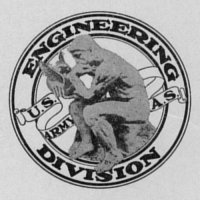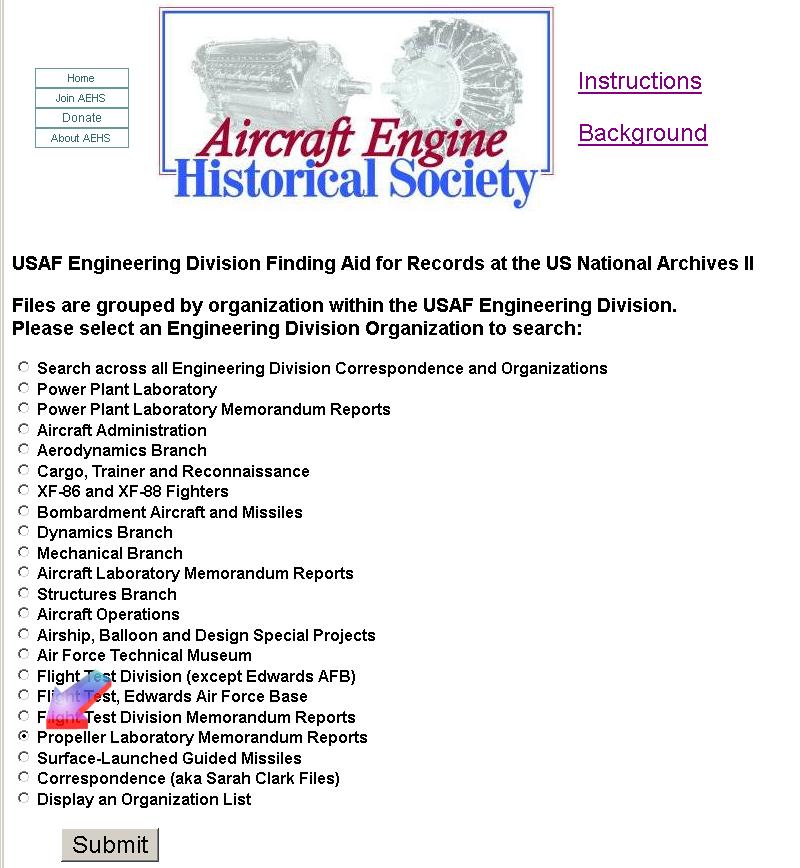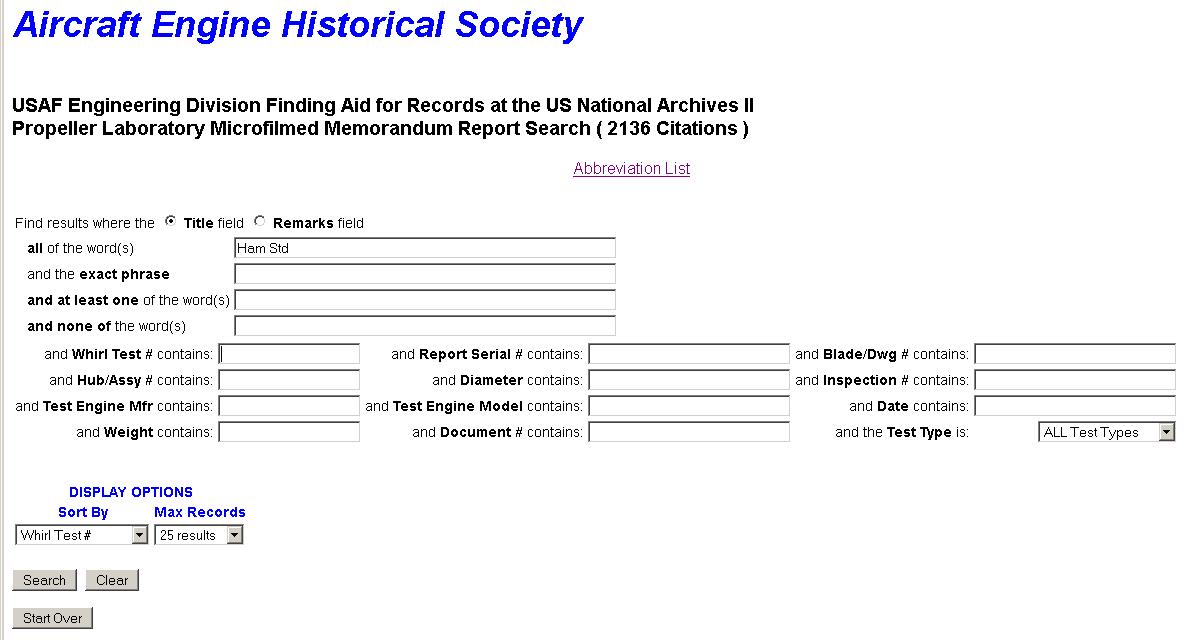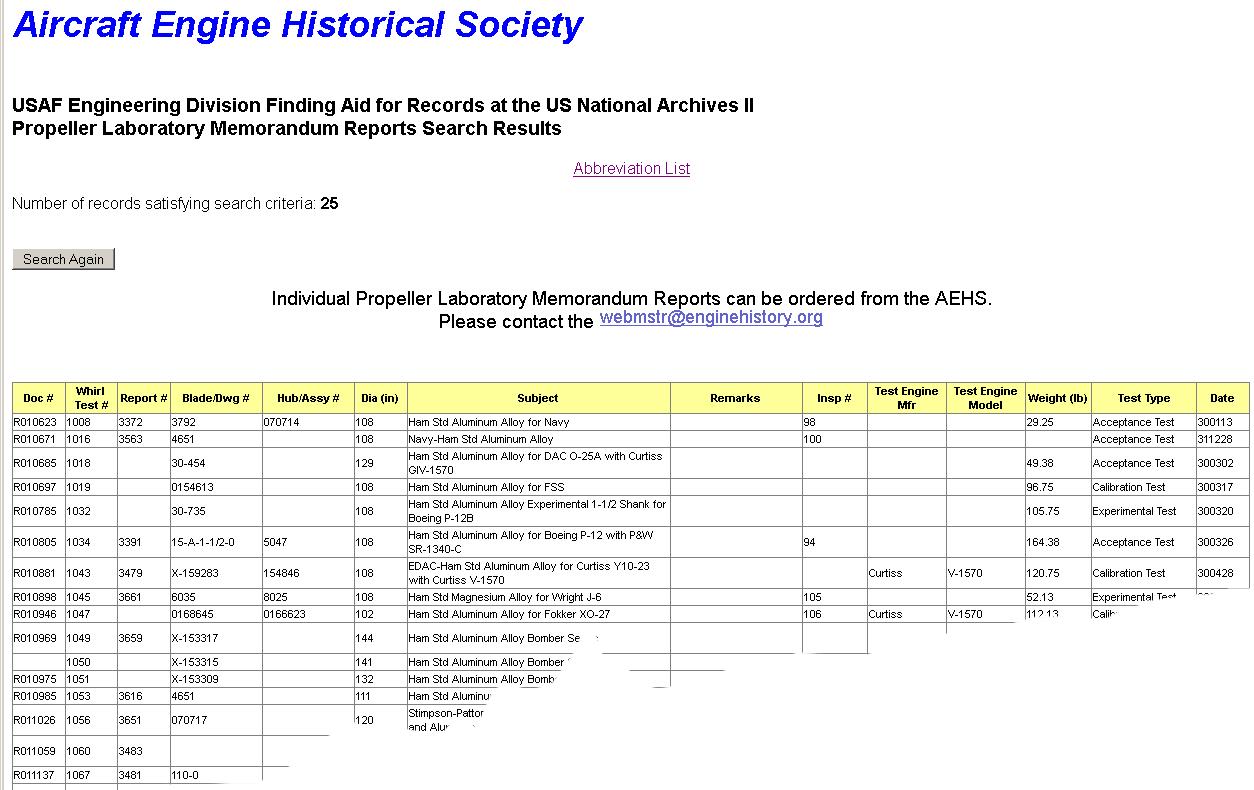
USAF Engineering Division Finding Aid
Instructions for Searching Propeller Laboratory Microfilmed Memorandum Reports.
 |
The Propeller Testing Laboratory began operation on 1 Oct 1918 at McCook Field, Dayton, Ohio. At its core was a streamlined propeller whirl-test rig that was the largest and most powerful in the world. The Propeller Laboratory and its predecessors conducted research, development, design and tests directed at the continuous improvement of aeronautical propulsion materiel, including propeller systems, rotors and auxiliary equipment. Until Jul 1939 the Propeller Unit functioned within the Aircraft Branch under the Experimental Engineering section. Thereafter it was established as the Propeller Laboratory with rank co-equal to all other laboratories of the Experimental Engineering Section. |
Instructions
Visit the Finding Aid, select the Propeller Laboratory Memorandum Reports radio button and click Submit

The Search Process
This search process involves a Search Form and a Results Form.
The Search Form
Below is part of an example Search Form:

Clicking the Search button with no search criteria specified produces a Results Form that can be used to browse the Propeller Laboratory Memorandum Reports. Here we have entered "Ham Std" (the abbreviation for Hamilton Standard), which has produced the Results form that appears below.

The Results Form
Search criteria entered in the Search form and Results produced by the search may include abbreviations for the designers and manufacturers of aircraft, engines and propellers. A link to a current list of these abbreviations appears on both the Search and Results forms.
Click here for a current abbreviations list.
In order to specify useful search criteria, one must understand what appears on the Results Form, so we will cover it first and then return to the Search Form.
Please remember that the object of this finding aid is to tell one where the records are located at the National Archives II (hereafter Archives). Whereas nearly all other Organizations usually require an Archives visit to view the records, Propeller Laboratory Mircofilmed Memorandum Reports can be ordered!
Result form fields are further explained below.
The Doc # is analogous to a microfilm roll and frame.
Doc #s are structured as follows: Orrffff where,
O = the Engineering Division Organization that originated the Memorandum Reports (A = Aircraft Laboratory; F = Flight Test Division; P = Power Plant Laboratory; R = Propeller Laboratory)
rr = the Microfilm Roll Number within the Organization's Microfilmed Memorandum Reports
ffff = the Frame Number on the Microfilm Roll
Hence, F121208 means that the Flight Test Division Memorandum Report begins on Flight Test Division Microfilm Roll 12, frame number 1208.The Date field specifies the date or date range during which a project was active. Conventions for the dates take several different forms:
The Whirl Test # was a unique number assigned to each whirl test.
The Report # (report serial number)was assigned to some reports.
The Blade/Dwg # was a number assigned to the propeller blade or blade drawing that was used for the test. Complete propeller specifications consisted of a Hub/Assy # and a Blade/Dwg #.
The Hub/Assy # was a number assigned to the propeller hub or hub assembly that was used for the thest. Complete propeller specifications consisted of a Hub/Assy # and a Blade/Dwg #.
The Dia (in) was the overall propeller diameter in inches.
The Title field is the whole point of this Finding Aid. Titles were assigned by AEHS volunteer subject specialists and include keywords that will make searching easier.
The Remarks field expands on the Subject to provide additional information, such as the type and quantity of data.
The Insp # was the insepction number assigned to the test.
The Test Engine Mfr was the test engine manufacturer. Some tests were run on actual engines instead of the whirl test rig.
The Test Engine Model was the test engine model used for the test.
The Weight (lb) was the weight in pounds, typically of the complete propeller; exceptions are usually noted.
The Test Type describes the type of test that was run on the subject propeller.
Search Again: Clicking on Search Again returns to a CLEARED Search Form. If you desire to return to the search form and preserve the search criteria, use the browser's "BACK" button.
The Search Form Revisited

The Search Form allows one to specify criteria that govern the number of "hits" returned by the search. Note that one does not have to specify anything in any of the fields. The purpose of any search specification is to simply reduce the number of search hits to those meeting the specified criteria. When search criteria are specified, the search will return results matching ALL of the search criteria that are specified. Clicking the Search button with all of the fields blank returns as many "hits" as is specified by the Max Records pull-down menu located under DISPLAY OPTIONS.
One can search any of the fields that appear on the Results form by entering the appropriate search criteria on the Search form. The _ (underscore) wild card character may be used within most of the field specifications to match any single character.
The text of either the Subject or Remarks fields can be searched by selecting either the Subject or Remarks radio button and entering words or phrases into the next series of menus, which produce results as outlined below:
all of the words: results containing ALL of the words in this field (separated by spaces, in any order) are returned.
the exact phrase: results containing the exact phrase specified in this field are returned.
at least one of the words: results containing one of the list of specified words.
none of the word(s): results that contain any of the words in this field (separated by spaces), in any order, are excluded from the results returned.
The _ wild card character may be used within the Title or Remarks specification to match any single character.
DISPLAY OPTIONS
Sort by allows one to select which column on the Results Form will be used to sort the results.
Sort by pull-down menu allows selection of the result field that will be used to sort the results. Results will be sorted in ascending order within the selected column. If no sort criteria is entered, results are returned in Whirl Test # order.
Max Records allows one to limit the maximum number of results that will be returned. The default is 25.
Visit the USAF Engineering Division the Finding Aid